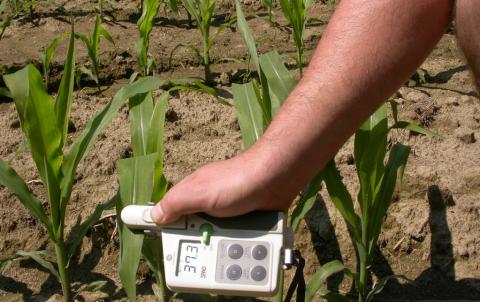Mid-Season Corn Nitrogen Checks
Checking your corn to see if it’s likely to have enough nitrogen for the remainder of the season is a good idea any year, but it’s likely to be especially important this summer. The high amounts of rainfall we’ve had throughout May – nearly twice the normal amount - and June has greatly increased the chance for nitrogen losses from leaching or denitrification.
And yet, there may be at least some remaining in the soil. There’s a reservoir of organic nitrogen temporarily stored in manure or crop residues that gets released once those materials decompose when the soil warms up. Given the weather we’ve had so far it may not be much, but you’ll still want to take it into account when figuring out whether to sidedress fields. That’s where mid-season testing comes in, and there are a couple different methods to choose from.
SPAD chlorophyll meter readings measure the concentration of chlorophyll in leaves, which is tied to how much nitrogen the crop has taken up. They have the advantage of giving you results as soon as you exit the field, but the meter itself is too expensive for most farms to justify the expense. Instead, talk to your crop advisor (or us!) about arranging to take some readings.
Alternately, the pre-sidedress nitrate test (PSNT) has been around for more than forty years, and while it can take up to a week to get results it doesn’t require any specialized equipment beyond a soil probe and a bucket. You collect soil samples when the corn is about a foot tall, just before its greatest nitrogen uptake, and if the results come back with 25 ppm nitrate or higher then it’s unlikely that your corn will respond to additional sidedressed nitrogen. There are several commercial and University-run laboratories in the region that provide this service.
Whichever route you go, pay attention to the details to get the most accurate results. Improper sample handling, or testing at the wrong time, can give artificially high or low numbers, meaning that you could either mistakenly be under the impression that there’s no need to sidedress, or that you’re spending money on nitrogen that your crops don’t need. Take SPAD meter readings when the corn is at least at the V6 stage, and you can even go as late as V7-8. If you opt for taking PSNTs, sample to the proper depth (that’s 12 inches, and I realize that might be challenging in some locations) and keep the samples chilled – not frozen – until you get them back home. Ship the samples to the lab overnight, or air dry them; it’s fine to put them in front of a fan to speed up the process, but keep them out of the oven.
Also keep in mind that while chlorophyll meter readings and PSNTs are both excellent tools, they have their limitations. Both are essentially snapshots in time; they provide a picture of the status of your fields when the readings or the samples were taken. A week of steady rain could mean that a field with sufficient nitrogen no longer has enough to see the crop through. Keep monitoring your fields, and be ready to reevaluate based on weather conditions.

